The Effect of Mindfulness-Based Music Therapy on Attention and Mood in Women Receiving Adjuvant Chemotherapy for Breast Cancer: A Pilot Study
Purpose/Objectives: To explore the efficacy of mindfulness-based music therapy (MBMT) to improve attention and decrease mood distress experienced by women with breast cancer receiving adjuvant chemotherapy.
Design: Quantitative, descriptive, longitudinal approach.
Setting: A comprehensive cancer hospital and a university in southern Florida.
Sample: 15 women with a diagnosis of breast cancer, stages I–III, receiving adjuvant chemotherapy.
Methods: Participants individually received MBMT for one hour per week for four weeks. The sessions consisted of varied music activities accompanied by mindfulness attitudes, or mental strategies that enhance moment-to-moment awareness, and weekly homework. Demographic information was collected at baseline.
Main Research Variables: Attention was measured using Conners’ Continuous Performance Test II. Mood was measured using the Profile of Mood States–Brief Form. Narrative comments collected from the homework assignments served to reinforce quantitative data.
Findings: Repeated measures analysis of variance showed that attention improved significantly over time. Although all mood states significantly improved from the beginning to the end of each MBMT session, the mood state of fatigue decreased significantly more than the other mood states.
Conclusions: MBMT enhances attention and mood, particularly the mood state of fatigue, in women with breast cancer receiving adjuvant chemotherapy.
Implications for Nursing: A preferred music listening and mindfulness exercise may be offered to women with breast cancer who experience attention problems and mood distress.
Jump to a section
Cancer treatments, such as chemotherapy and radiation therapy, are thought to damage normal cognitive functioning of women with breast cancer (Reuter-Lorenz & Cimprich, 2013; Von Ah & Tallman, 2014). Mindfulness, a type of contemplative practice, improves cognitive functions, including attention and working memory, in adults (Jha, Krompinger, & Baime, 2007; Jha, Stanley, & Baime, 2010; Tang et al., 2007). Music stimuli are an ideal source of focus for mindfulness practice (Graham, 2010). No study, to date, has used mindfulness-based music therapy (MBMT) to address the attention deficits and symptom distress reported by women who receive chemotherapy treatments. This pilot study explores the efficacy of MBMT to reduce attention problems and mood distress experienced by women receiving adjuvant chemotherapy for breast cancer.
Neurocognitive deficits in women with breast cancer have been associated with a phenomenon referred to as “chemo brain” (Hurria, Somlo, & Ahles, 2007; Reuter-Lorenz & Cimprich, 2013). Chemotherapy treatments are reported to negatively affect domains of attention, working memory, and several psychomotor abilities (Correa & Ahles, 2008; Hurria et al., 2007; McDonald & Saykin, 2011). A meta-analysis that evaluated the effects of chemotherapy on women with breast cancer revealed significantly lower cognitive ability for executive function, information processing speed, verbal memory, and visual memory as compared to normative data (Reuter-Lorenz & Cimprich, 2013). Deficits in cognitive function were also found in women who had received adjuvant chemotherapy for breast cancer six months postchemotherapy (Jim et al., 2012). In addition, brain-imaging techniques revealed a reduction of brain gray matter density in patients who received chemotherapy for breast cancer (McDonald & Saykin, 2011). The reduced density was observed bilaterally in the frontal and temporal brain regions one month after chemotherapy treatments relative to baseline density. The changes in gray matter were not found in patients with breast cancer who were not treated with chemotherapy or who were healthy controls. One year later, patients showed partial recovery of gray matter (McDonald & Saykin, 2011).
Women with breast cancer receiving adjuvant chemotherapy report frequently having problems with focus, attention, and short-term memory; one typical complaint is that they often forget where they put their car keys. Improvement in attention ability is much desired by these patients and their physicians (A. Montero, personal communication, July 13, 2012). Treatment can interfere with the activities of daily living; poor information processing, attention, and working memory also are negatively associated with treatment (Brezden, Phillips, Abdolell, Bunston, & Tannock, 2000; Jansen, Miaskowski, Dodd, Dowling, & Kramer, 2005; Von Ah & Tallman, 2014). In addition, negative mood states (e.g., anxiety, fatigue, depression) are often observed in women with breast cancer (Berger & Higginbotham, 2000). Fatigue is a common complaint and is rated as the longest lasting and most disruptive symptom that results from adjuvant chemotherapy treatment (Berger & Higginbotham, 2000; Carlson et al., 2004, 2013). These areas of concern for patients and healthcare providers require intervention, and one noninvasive approach may be offered by mindfulness: MBMT.
Mindfulness
Mindfulness is a contemplative practice of being fully aware of what is occurring in the present moment (Bishop et al., 2004; Brotto, 2013). It involves paying attention to an item, event, or moment without overanalyzing, evaluating, or judging. The practice of mindfulness can help a person not to worry about the past or the future, as well as to move out of automatic pilot responses (Brown & Ryan, 2003; Kabat-Zinn, 1990; Williams, Teasdale, Segal, & Kabat-Zinn, 2007). Sometimes referred to as the third wave of psychology, mindfulness is useful as an approach for increasing awareness and responding skillfully to mental processes that contribute to emotional distress and maladaptive behavior (Bishop et al., 2004). Mindfulness involves being aware of and attentive to the form of thoughts rather than the content of thoughts. Whereas cognitive behavior therapy emphasizes addressing the content of distressing thoughts and reframing them, mindfulness entails being aware of having those types of thoughts, feelings, and body sensations. This sort of functioning is referred to as pre-reflexive because it acts on, not within, thought, feeling, and other forms of consciousness (Brown & Ryan, 2003).
Cognitive mechanisms have been reported as significantly improving with the practice of mindfulness (Zeidan, Johnson, Diamond, David, & Goolkasian, 2010), even when practiced in the short term (Tang et al., 2007). Benefits of mindfulness practice include increased focus and self-regulation (Baer, 2003), as well as increased attention and working memory (Chiesa, Calati, & Serretti, 2011; Jha et al., 2007, 2010). Significant improvements in mood and sleep (Carlson & Garland, 2005; Carlson et al., 2013) and increased well-being (Brown & Ryan, 2003) were reported by women with breast cancer who participated in a mindfulness-based stress reduction (MBSR) program. In a randomized, wait-list controlled study, the mood and symptoms of stress of outpatients with cancer significantly improved after partaking in weekly 1.5-hour MBSR sessions for seven weeks (Speca, Carlson, Goddey, & Angen, 2000). The MBSR program consisted of three components: teaching materials pertaining to relaxation and meditation, experiential practice of meditation in group and home settings, and group work focused on problem solving. The patients had varied cancer diagnoses, stages of illness, and ages; breast cancer constituted the largest subgroup. A significantly reduced mood disturbance was found for the Profile of Mood States–Brief Form (POMS-BF) subscales of anxiety, depression, anger, and confusion (McNair & Heuchert, 2006). A significant increase in vigor was also reported, whereas fatigue was not found to be significantly improved (Speca et al., 2000).
Graham (2010) found that music stimuli may serve as an ideal source of focus for mindfulness. Although mindfulness-based art therapy was found to significantly reduce symptom distress in women with cancer (Monti et al., 2006), its efficacy to improve attention was not investigated. The practice of mindfulness and music therapy was presented to conference attendees at the 14th World Congress of Music Therapy (Lesiuk, 2014). However, to the author’s knowledge, no known studies of MBMT examine the effects of cognition in any patient population. This article examines the effect of an MBMT program on attention and mood states in women receiving adjuvant chemotherapy for breast cancer. The findings reported in the current article may contribute to nursing and mindfulness-based practices, as well as to music therapy literature and clinical practice.
Methods
Study Design and Procedure
This study aimed to determine (a) the effect of MBMT on participant attention, as measured by the Conners’ Continuous Performance Test II (CPT-II), version 5, prior to and following the four-week MBMT program (Conners, 2004) and (b) the immediate effect of MBMT on participant mood, as measured by POMS-BF. A descriptive, longitudinal design was used. Demographic information was collected at baseline. Attention was measured by eight subscales and at two time points (once at baseline [Time 1] and again at the completion of the study [Time 2]). Mood was measured using the POMS-BF at the beginning (pre) and end (post) of each weekly one-hour session. Each MBMT weekly session differed by theme.
The study received participants research approval from the Sylvester Comprehensive Cancer Center, part of the University of Miami Health System, and the University of Miami, both in Florida. An MBMT program was developed by the author to potentially enhance the attention and mood states of women who received adjuvant chemotherapy for breast cancer. Participants in the MBMT program received individualized one-hour MBMT sessions once a week for four weeks in a comfortable room within the Frost School of Music at the University of Miami. Participants were also assigned 15–20 minutes of daily homework consisting of music listening exercises and written reflections that matched the weekly theme and mindfulness attitude, respectively. Each week, participants were provided with a different music CD created by the author.
The POMS-BF, measuring mood state, was administered immediately prior to and following each session. The CPT-II, measuring attention, was administered immediately prior to the first session and following the end of the fourth session. All participants completed the four MBMT sessions. Table 1 shows the various music therapy activities by week and the accompanying four mindfulness attitudes, which are mental strategies that allow individuals to enhance their practice of being in the moment. Each session began with an opening exercise using sound and then music as the anchor for attention. The opening exercise, which lasted about five to seven minutes, was developed to introduce focus on sound and music rather than on breath, which is the traditional focus (Graham, 2010). Discussions followed regarding whether participants’ minds wandered or remained on the sound, as well as whether they could simply observe their thoughts, feelings, and body sensations without reacting to them. The full disclosure of the program requires a lengthy description beyond the purpose of the findings reported here. Therefore, MBMT program development, a detailed description of the program, and narrative comments from homework are provided for readers elsewhere (Lesiuk, 2014). 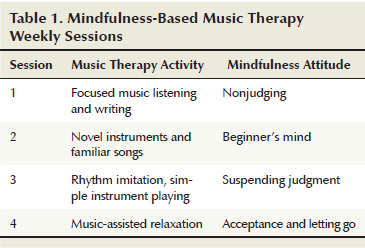
Participants
Fifteen women with a diagnosis of breast cancer were recruited from the Sylvester Comprehensive Cancer Center. The women traveled to the clinic for their appointments and chemotherapy treatments. All participants spoke English fluently. Criteria for inclusion in the study were a diagnosis of breast cancer (stages I–III) and current adjuvant chemotherapy treatment. Exclusion criteria included any prior cognitive impairment (e.g., head injury, history of psychosis). Women who met the study criteria were identified by the clinic nurse and were provided with information about the MBMT study from the researcher. Session meeting times that were agreeable to each participant were scheduled.
Measures
Conners’ Continuous Performance Test II: The CPT-II is a 14-minute-long computerized assessment of attention, impulsivity, and vigilance. The CPT-II may be used as a screening tool to monitor the effectiveness of treatment and medication or for research purposes. The CPT-II profiles produced help to identify potential problems of executive function in clinical populations. During administration of the CPT-II, participants press a computer keyboard spacebar as quickly and accurately as possible for every screen display of a letter of the alphabet, except for the letter “X.” Following administration of the CPT-II, a score report in which participant raw scores are converted to t scores is generated. These scores may be compared to those of individuals in the normative group of the same gender and age range.
For the purpose of this study, CPT-II scores specifically related to the measure of attention were analyzed. For example, a t score of omissions indicates failing to respond to the target alphabet letters, and a t score of commission errors indicates responses incorrectly given to the nontarget letter, “X.” Several response times are calculated in milliseconds for the remaining measures (i.e., hit reaction time, hit reaction time standard error, variability, detectability, reaction interstimulus interval change, and standard error by interstimulus interval). All of these scores constitute a measure of attention for each participant. Detailed explanations of the response times are provided by Conners (2004). CPT-II measures, when combined into indices for neurologic assessment, have a reliability coefficient of 0.92 (Conners, 2004).
Profile of Mood States–Brief Form: POMS-BF consists of 30 items regarding how an individual feels at the time of testing. This mood scale is efficient at differentiating the effects of experimental manipulations of mood in patients with cancer (Andersen et al., 2007). The brief version was developed in 1989 for the purpose of providing a shorter and less time-consuming form to patients in medical settings. For each of the six POMS-BF subscales (i.e., anger-hostility, confusion-bewilderment, depression-dejection, fatigue-inertia, tension-anxiety, and vigor-activity), patients respond to items on a five-point Likert-type scale by circling numbers from 0 (not at all) to 4 (extremely). For example, items within the tension-anxiety subscale include “tense, shaky,” whereas items within the vigor-activity subscale include “lively, vigorous.” All internal consistencies of the factors are high, with 0.9 or above (McNair & Heuchert, 2006). Relatively lower stability coefficients are expected for the POMS-BF scale; individuals’ state moods fluctuate because of situational factors in the time they are captured.
Data Analysis
Data were analyzed using SPSS®, version 22, and all statistical assumptions were met. A repeated measures analysis of variance (ANOVA) was used for analysis of the effect of MBMT on participant attention over time. A repeated measures ANOVA was used for analysis of the effect of MBMT on participant mood from each of the four weekly pre- and postsessions. All 15 participants completed the four sessions. Participants were not required to log homework time. However, participants were asked at the end of the study how much time, on average, they had spent on homework per week; time spent ranged from 30 minutes to seven hours. Missing items found infrequently on the POMS-BFscales were averaged with similar subscale item responses prior to data entry.
Results
Participants
The mean age of the 15 participants was 52.6 years (SD = 11.3, range = 27–70 years). All participants were receiving adjuvant chemotherapy while enrolled in the MBMT study. Most participants received chemotherapy every three weeks for six cycles. Participants had, on average, 1.9 years (SD = 3.25, range = 0–10 years) of music training. Two of the women were involved in active music making (e.g., singing in a choir), and five had some previous experience with meditation (see Table 2).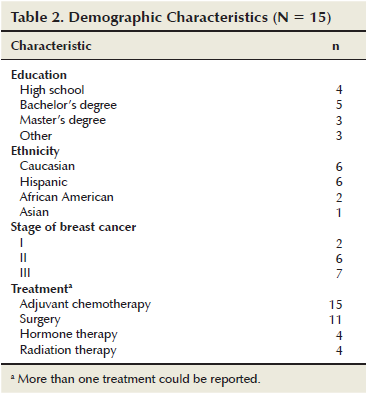
Attention
A repeated measures ANOVA revealed that the two-way interaction of time with attention is not significant (see Table 3). However, the main effect of time is statistically significant (F [1, 14] = 6.69, p = 0.022). The attention t score at Time 1 is 51.54 (SE = 1.76) and 46.94 (SE = 0.87) at Time 2. The significantly lower score at Time 2 indicates an improvement in attention over time. Figure 1 illustrates the attention measure over time. 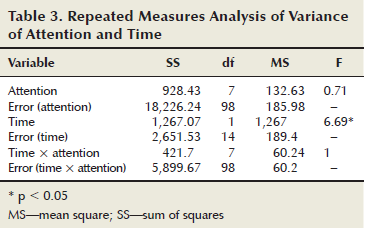
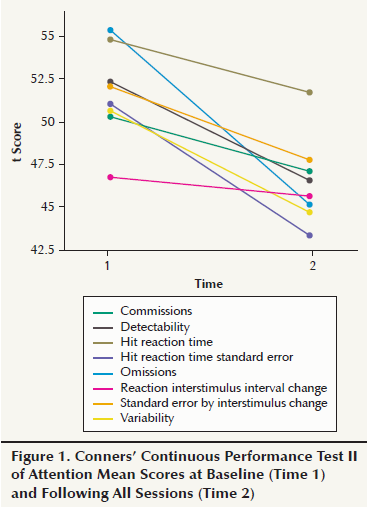
Mood Distress
A repeated measures ANOVA revealed that the change in mood from the beginning to the end of each session did not vary by the type or the theme of the session for each subscale. However, the change in mood from the beginning to the end of each session differed by subscale across all sessions (F [5, 65] = 20.83, p < 0.001). Although a statistically significant reduction in mood disturbance from the beginning to the end of the MBMT sessions was observed, the magnitude of the change was not the same across all mood states.
Figure 2 illustrates the overall mean of the POMS-BF subscales at the beginning (pre) and end (post) of the MBMT sessions. All mood states of the participants improved from the start to the end of all four MBMT sessions. Post-hoc pairwise comparisons reveal ed that fatigue decreased significantly more than the other negative mood states. The mean of the fatigue-inertia subscale pretest was 6.13, and the post-test mean was 1.43, with the largest subscale difference score being 4.7 (p < 0.001). 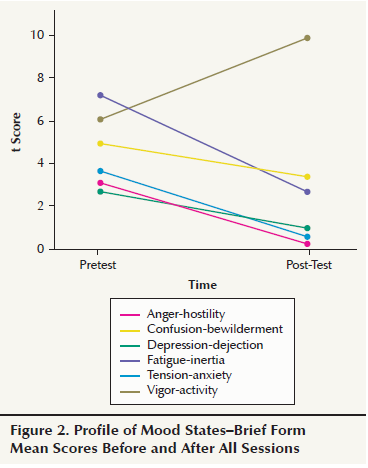
A follow-up analysis using Bonferroni correction to control for overall alpha level shows significant mean differences between pretest and post-test for each POMS-BF subscale (see Table 4). These improvements in mood state indicate a relevant change in symptom distress of the women. 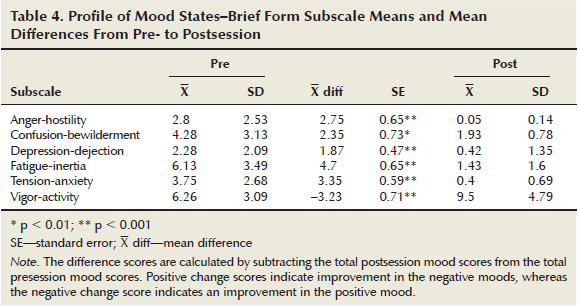
Discussion
This pilot study found that the MBMT program significantly improved attention over time. This significant improvement in attention over time reinforces the findings posited by Chiesa et al. (2011) and Jha et al. (2007) that mindfulness-based interventions significantly improve attention. In addition, music stimuli appear to be an excellent way to capture attention for passive listening (Huron, 1992) and active music making (Gardiner, 2005).
The results of this pilot study also determined that MBMT significantly reduced negative mood states in women with breast cancer who were receiving adjuvant chemotherapy. Specifically, the MBMT intervention significantly reduced states of tension, depression, anger, fatigue, and confusion in women with breast cancer, and it significantly improved their levels of vigor and activity. Statements made by the women during the MBMT corroborate the quantitative findings regarding mood states. For example, some women reported feeling more relaxed and less stressed, as well as being able to sleep better. The problem of fatigue frequently reported by women receiving adjuvant chemotherapy treatment for breast cancer (Berger & Higginbotham, 2000) showed the greatest decrease following the MBMT sessions. The significant reduction in negative mood states, particularly fatigue, and the marked improvement in vigor confirms the benefits for mood alteration from a MBMT intervention. Speca et al. (2000) did not find improvements in fatigue in the use of an MBSR program for patients with cancer; however, fatigue was reduced significantly with MBMT. Perhaps the MBMT program, with its combined emphasis on enhancing attention and reducing mood distress, is particularly effective for fatigue reduction.
Although the development, detailed description, and participant narrative comments of the MBMT program are provided for readers elsewhere (Lesiuk, 2014), the following participant comment, taken from a participant’s homework journal regarding acceptance and letting go, corroborates the finding that negative moods can be altered through MBMT.
This week, the music was extremely relaxing and beautiful. . . . My mood, thoughts, and feelings changed. I was apprehensive, nervous, etc. Now, I feel acceptance, relaxed, ready for the approaching surgery—totally with a positive attitude!
The current study is limited by a small sample size and the absence of a wait-list control condition. In addition, although chemotherapy treatments were concurrent with the MBMT sessions, they varied in duration prior to the MBMT sessions. For example, some women had completed only one-third or one-half of their treatments when they began the study, whereas others were closer to completing the prescribed cycles of chemotherapy. Future research investigations should account for the length of time and number of cycles of chemotherapy received prior to and during MBMT. Attention and mood responses may be variable based on the length of time on chemotherapy and the number of chemotherapy cycles women had been receiving.
Recommendations for a more comprehensive research study beyond this pilot study include use of a larger number of participants and a wait-list control condition. MBMT could also be offered in a small-group format as opposed to only individual sessions. The social connection available in a group setting may further enhance the benefits of MBMT for the women. Measuring the effect of MBMT on fatigue during stages of chemotherapy treatment (Berger & Higginbotham, 2000) would elucidate the strength of the MBMT to reduce fatigue. Women with stage IV breast cancer were excluded from participation in the current study, but a study of the effect of MBMT on symptom distress and quality of life for women with stage IV breast cancer is also recommended. Measures of perceived home and work-life stress also could be included to account for MBMT effectiveness when these factors are controlled for.
Implications for Nursing
Nurses who observe symptom distress and attention problems in women receiving adjuvant chemotherapy for breast cancer may help by facilitating a simple mindfulness-based music technique for their patients. For example, patients can be instructed to bring in their preferred music selections and focus on a particular attribute in the music (e.g., melody, specific instrument). In beginning mindfulness practice, the patient’s attention may naturally drift to thoughts, feelings, or body sensations. However, the patient should be instructed to gently guide her mind back to the particular attribute in the music. The patient should also be told to be aware of any thoughts and to watch them as a bystander would. This mindfulness exercise that involves being with the music in the moment can be practiced at any time.
Guided instructions for using preferred music listening to practice mindfulness are provided by Graham (2010) and Goldberg (2014). The music listening and mindfulness practice may not only be employed by patients, but also by nurses who desire to practice mindfulness. A music therapist may provide guidance to nursing staff regarding how to facilitate mindfulness-based music listening with their patients. Nursing administrators interested in providing MBMT for their patients should contact the American Music Therapy Association (www.musictherapy.org) or the author of the current article for assistance with locating music therapy services.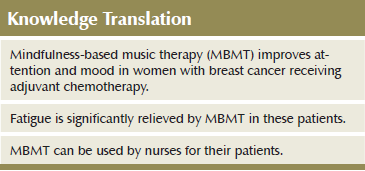
Conclusion
The unique contribution of music to mindfulness practice in the form of MBMT significantly improved attention and mood states for women receiving adjuvant chemotherapy for breast cancer. The symptom of fatigue, a common complaint of the women, was particularly alleviated by the MBMT treatment. This music-based intervention, although in need of further investigation with a larger sample, is promising for the relief of symptom distress and to allay the attention problems associated with chemobrain.
References
Andersen, B.L., Farrar, W.B., Golden-Kreutz, D., Emery, C.F., Glaser, R., Crespin, T., & Carson, W.E., III. (2007). Distress reduction from a psychological intervention contributes to improved health for cancer patients. Brain, Behavior, and Immunity, 21, 953–961. doi:10.1016/j.bbi.2007.03.005
Baer, R.A. (2003). Mindfulness training as a clinical intervention: A conceptual and empirical review. Clinical Psychology: Science and Practice, 10, 125–143. doi:10.1093/clipsy.bpg015
Berger, A.M., & Higginbotham, P. (2000). Correlates of fatigue during and following adjuvant breast cancer chemotherapy: A pilot study. Oncology Nursing Forum, 27, 1443–1448.
Bishop, S.R., Lau, M., Shapiro, S., Carlson, L., Anderson, N.D., Carmody, J., . . . Devins, G. (2004). Mindfulness: A proposed operational definition. Clinical Psychology: Science and Practice, 11, 230–241. doi:10.1093/clipsy.bph077
Brezden, C.B., Phillips, K.A., Abdolell, M., Bunston, T., & Tannock, I.F. (2000). Cognitive function in breast cancer patients receiving adjuvant chemotherapy. Journal of Clinical Oncology, 18, 2695–2701.
Brotto, L.A. (2013). Orienting to the present moment. Sexual and Relationship Therapy, 28, 1–2. doi:10.1080/14681994.2013.784000
Brown, K.W., & Ryan, R.M. (2003). The benefits of being present: Mindfulness and its role in psychological well-being. Journal of Personality and Social Psychology, 84, 822–848. doi:10.1037/0022-3514.84.4.822
Carlson, L.E., Angen, M., Cullum, J., Goodey, E., Koopmans, J., Lamont, L., . . . Bultz, B.D. (2004). High levels of untreated distress and fatigue in cancer patients. British Journal of Cancer, 90, 2297–2304.
Carlson, L.E., Doll, R., Stephen, J., Faris, P., Tamagawa, R., Drysdale, E., & Speca, M. (2013). Randomized controlled trial of mindfulness-based cancer recovery versus supportive expressive group therapy for distressed survivors of breast cancer. Journal of Clinical Oncology, 31, 3119–3126. doi:10.1200/JCO.2012.47.5210
Carlson, L.E., & Garland, S.N. (2005). Impact of mindfulness-based stress reduction (MSBR) on sleep, mood, stress and fatigue symptoms in cancer outpatients. International Journal of Behavioral Medicine, 12, 278–285. doi:10.1207/s15327558ijbm1204_9
Chiesa, A., Calati, R., & Serretti, A. (2011). Does mindfulness training improve cognitive abilities? A systematic review of neuropsychological findings. Clinical Psychology Review, 31, 449–464. doi:10.1016/j.cpr.2010.11.003
Conners, C.K. (2004). Conners’ Continuous Performance Test (CPT II) for Windows. North Tonawanda, NY: Multi-Health Systems.
Correa, D.D., & Ahles, T.A. (2008). Neurocognitive changes in cancer survivors. Cancer Journal, 14, 396–400. doi:10.1097/PPO.0b013e31818d8769
Gardiner, J.C. (2005). Neurologic music therapy in cognitive rehabilitation. In M.H. Thaut (Ed.), Rhythm, music, and the brain: Scientific foundations and clinical applications (pp. 179–201). New York, NY: Taylor and Francis Group.
Goldberg, A. (2014). Preferred music-based mindfulness: A new intervention for stress reduction (Unpublished doctoral dissertation). Sofia University, Palo Alto, CA.
Graham, R. (2010). A cognitive-attentional perspective on the psychological benefits of listening. Music and Medicine, 2, 167–173. doi:10.1177/1943862110372522
Huron, D. (1992). The ramp archetype and the maintenance of passive auditory attention. Music Perception: An Interdisciplinary Journal, 10, 83–91. doi:10.2307/40285540
Hurria, A., Somlo, G., & Ahles, T. (2007). Renaming “chemobrain.” Cancer Investigation, 25, 373–377. doi:10.1080/07357900701506672
Jansen, C.E., Miaskowski, C., Dodd, M., Dowling, G., & Kramer, J. (2005). A meta-analysis of studies of the effects of cancer chemotherapy on various domains of cognitive function. Cancer, 104, 2222–2233.
Jha, A.P., Krompinger, J., & Baime, M.J. (2007). Mindfulness training modifies subsystems of attention. Cognitive, Affective, and Behavioral Neuroscience, 7, 109–119. doi:10.3758/cabn.7.2.109
Jha, A.P., Stanley, E.A., & Baime, M.J. (2010). What does mindfulness training strengthen? Working memory capacity as a functional marker of training success. In R.A. Baer (Ed.), Assessing mindfulness and acceptance processes in clients: Illuminating the theory and process of change (pp. 207–221). Oakland, CA: New Harbinger.
Jim, H.S., Phillips, K.M., Chait, S., Faul, L.A., Popa, M.A., Lee, Y.H., . . . Small, B.J. (2012). Meta-analysis of cognitive functioning in breast cancer survivors previously treated with standard-dose chemotherapy. Journal of Clinical Oncology, 30, 3578–3587. doi:10.1200/JCO.2011.39.5640
Kabat-Zinn, J. (1990). Full catastrophe living: Using the wisdom of your body and mind to face stress, pain, and illness. New York, NY: Delta.
Lesiuk, T. (2014, July). The development of mindfulness-based music therapy (MBMT) program for women with breast cancer. Paper presented at the 14th World Congress of Music Therapy, Krems, Austria.
McDonald, B.C., & Saykin, A.J. (2011). Neurocognitive dimensions of breast cancer and its treatment. Neuropsychopharmacology, 36, 355-356. doi:10.1038/npp.2010.142
McNair, D.M., & Heuchert, J.W.P. (2006). POMS: Profile of Mood States technical update. North Tonawanda, NY: Multi-Health Systems.
Monti, D.A., Peterson, C., Kunkel, E.J., Hauck, W.W., Pequignot, E., Rhodes, L., & Brainard, G.C. (2006). A randomized, controlled trial of mindfulness-based art therapy (MBAT) for women with cancer. Psycho-Oncology, 15, 363–373. doi:10.1002/pon.988
Reuter-Lorenz, P.A., & Cimprich, B. (2013). Cognitive function and breast cancer: Promise and potential insights from functional brain imaging. Breast Cancer Research and Treatment, 137, 33–43. doi:10.1007/s10549-012-2266-3
Speca, M., Carlson, L., Goddey, E., & Angen, M. (2000). A randomized wait-list controlled trial: The effects of a mindfulness meditation-based stress reduction program on mood and symptoms of stress in cancer outpatients. Psychosomatic Medicine, 62, 613–622. doi:10.1097/00006842-200009000-00004
Tang, Y.Y., Ma, Y., Wang, J., Fan, Y., Feng, S., Lu, Q., . . . Posner, M.I. (2007). Short-term meditation training improves attention and self-regulation. Proceedings of the National Academy of Sciences of the United States of America, 104, 17152–17156. doi:10.1073/pnas.0707678104
Von Ah, D., & Tallman, E.F. (2014). Perceived cognitive function in breast cancer survivors: Evaluating relationships with objective cognitive performance and other symptoms using the functional assessment of cancer therapy-cognitive function instrument. Journal of Pain and Symptom Management. Advance online publication. doi:10.1016/j.jpainsymman.2014.08.012
Williams, M., Teasdale, J., Segal, Z., & Kabat-Zinn, J. (2007). The mindful way through depression: Freeing yourself from chronic unhappiness. New York, NY: Guilford Press.
Zeidan, F., Johnson, S.K., Diamond, B.J., David, Z., & Goolkasian, P. (2010). Mindfulness meditation improves cognition: Evidence of brief mental training. Consciousness and Cognition, 19, 597–605. doi:10.1016/j.concog.2010.03.014
About the Author(s)
Teresa Lesiuk, PhD, MT-BC, is the director of and an associate professor in the music therapy program in the Frost School of Music at the University of Miami in Coral Gables, FL. This study was funded, in part, by the Provost’s Research Award from the University of Miami. Lesiuk can be reached at tlesiuk@miami.edu, with copy to editor at ONFEditor@ons.org. (Submitted July 2014. Accepted for publication December 12, 2014.)

